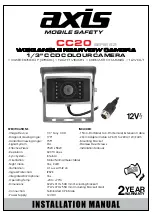
vi
Notices
In
trodu
ct
ion
FCC/IC RF Exposure Statement
The available scientific evidence
does not show that any health prob-
lems are associated with using low
power wireless devices. There is no
proof, however, that these low
power wireless devices are abso-
lutely safe. Low power wireless
devices emit low levels of radio fre-
quency energy (RF) in the micro-
wave range while being used.
Whereas high levels of RF can pro-
duce health effects (by heating tis-
sue), exposure to low-level RF that
does not produce heating effects
causes no known adverse health
effects. Many studies of low-level RF
exposures have not found any bio-
logical effects. Some studies have
suggested that some biological
effects might occur, but such find-
ings have not been confirmed by
additional research. Wireless LAN
Module (GC-131) has been tested
and found to comply with FCC/IC
radiation exposure limits set forth
for an uncontrolled equipment and
meets the FCC radio frequency (RF)
Exposure Guidelines in Supplement
C to OET65 and RSS-102 of the IC
radio frequency (RF) Exposure rules.
Please refer to the SAR test report
that was uploaded at FCC website.
This device should not be co-located
or operated in conjunction with any
other antenna or transmitter.
Notice for customers in the
U.S.A.
FCC RF Interference Statement
This equipment has been tested and
found to comply with the limits for a
Class B digital device, pursuant to
Part 15 of the FCC rules. These lim-
its are designed to provide reason-
able protection against harmful
interference in a residential installa-
tion. This equipment generates,
uses, and can radiate radio fre-
quency energy and, if not installed
and used in accordance with the
instructions, may cause harmful
interference to radio communica-
tions. However, there is no guaran-
tee that interference will not occur
in a particular installation. If this
equipment does cause harmful
interference to radio or television
reception, which can be deter-
mined by turning the equipment off
and on, the user is encouraged to
try to correct the interference by
one or more of the following mea-
sures:
• Reorient or relocate the receiving
antenna.
• Increase the separation between
the equipment and receiver.
• Connect the equipment into an
outlet on a circuit different from
that to which the receiver is con-
nected.
• Consult the dealer or an experi-
enced radio/television technician
for help.









































